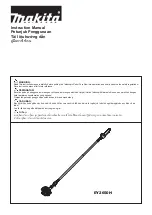
41
10 TROUBLESHOOTING
This chapter lists the probable faults and malfunctions that could occur while the machine is being
used and suggests possible remedies for solving them.
The first paragraph provides diagnosis for blades and cuts, the second for electrical components.
10.1 - Blade and cut diagnosis
Fault Probable
cause
Remedy
Tooth break-
age
Too fast advance
Wrong cutting speed
Wrong tooth pitch
Low quality blade
Ineffective gripping of the part in the vice
Previously broken tooth left in the cut
Cutting resumed on a groove made previously
Insufficient lubricating refrigerant or wrong
emulsion
Sticky accumulation of material on the blade
Decrease advance, exerting less cutting pressure.
Change blade speed and/or diameter (see chapter
9; “Material classification and choice of blade”).
Choose a suitable blade (see chapter 9; “Material
classification and choice of blade”).
Use a better quality blade.
Check the gripping of the part.
Accurately remove all the parts left in.
Make the cut elsewhere, turning the part.
Check the level of the liquid in the tank. Increase
the flow of lubricating refrigerant, checking that
the hole and the liquid outlet pipe are not blocked.
Check the blend of lubricating coolant and choose
a better quality blade.
Premature
blade wear
Wrong running in of the blade
Wrong cutting speed
Unsuitable tooth profile
Wrong tooth pitch
Low quality blade
Insufficient lubricating refrigerant
See chapter 9.5; “Running in the blade”.
Change blade speed and/or diameter (see chapter
9; “Material classification and choice of blade”).
Choose a suitable blade (see chapter 9; “Material
classification and choice of blade”).
Choose a suitable blade (see chapter 9; “Material
classification and choice of blade”).
Use a better quality blade.
Check the level of the liquid in the tank. Increase
the flow of lubricating refrigerant, checking that
the hole and the liquid outlet pipe are not blocked.
Chipped blade
Hardness, shape or flaws in the material (ox-
ides, inclusions, lack of homogeneity etc.)
Wrong cutting speed
Wrong tooth pitch
Vibrations
Blade incorrectly sharpened
Low blade quality
Incorrect emulsion of the lubricating refriger-
ant
Reduce the cutting pressure and/or the advance.
Change blade speed and/or diameter (see chapter
9; “Material classification and choice of blade”).
Choose a suitable blade (see chapter 9; “Material
classification and choice of blade”).
Check the gripping of the part.
Replace the blade with one that is more suitable
and correctly sharpened.
Use a better quality blade.
Check the percentage of water and oil in the emul-
sion.
Blade vibra-
tion
Wrong tooth pitch
Unsuitable tooth profile
Ineffective gripping of the part in the vice
Choose a suitable blade (see chapter 9; “Material
classification and choice of blade”).
Choose a suitable blade (see chapter 9; “Material
classification and choice of blade”).
Check the gripping of the part.





































